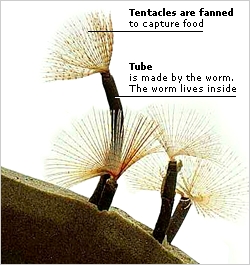DK Science: Feeding
Unlike plants, animals cannot make food from sunlight. Animals have to feed to produce the energy they need to grow, move, and reproduce. Some animals eat only plants, others eat meat, and some eat both. Most animals have a gut with a mouth at one end and an anus at the other. Food is broken down as it passes from one end of the gut to the other. The nutrients are absorbed into the body in a process called DIGESTION.

Many aquatic animals, including whales and basking sharks, take in food by filter feeding. Fan worms that live on seabeds use the tentacles around their mouths to filter food. As they draw water towards them with their tentacles, food particles are trapped in their tentacles with mucus. The food is then passed into their mouths.
Ospreys are birds of prey that feed entirely on fish. Like all predators, they have specially adapted features to help them catch prey. Osprey have powerful wings and feet that enable them to swoop down and grab fish. Birds do not have teeth but a muscular organ in their digestive system called a gizzard for grinding up food. This organ also prevents harmful bones from passing into the birds’ intestines.
Some deep-sea predators, such as angler fish, use lures to catch their prey. In deep water, food is often scarce, so attracting prey rather than chasing it saves energy. The angler fish’s lure glows in the dark. Once the prey is lured near enough, the enormous jaws of the fish snap shut.
Animals that eat both plants and animals are called omnivores. They are highly adaptable and use whatever food they can get hold of. Racoons, with their skilful hands, are particularly successful at finding food. Their diet ranges from fish and young birds to shoots and berries. Some omnivores are at home in urban areas, surviving on garden produce and waste.
Animals have found remarkable ways to hoard food. Honeypot ants create larders by selecting newly hatched worker ants to act as storage vessels. They are fed a mixture of honey and nectar, causing their abdomens to swell. In the dry season, when there is less food about, the other ants entice them to regurgitate droplets of food so they can all drink.
During digestion, animals break down food into pieces small enough to be absorbed. The process is made quicker by chemicals in the gut called enzymes. In some invertebrate animals, digestion begins outside the body, in others food is taken in through the mouth and then digested. In mammals, food is sometimes chewed before swallowing.

The teeth of a tiger are highly specialized for gripping and eating meat. The long, pointed canine teeth are used for biting into an animal’s neck. The carnassial (cheek) teeth pull flesh off bones or slice up meat with a scissor-like action.
Many spiders trap their prey in webs, paralysing any animal that becomes stuck with a venomous bite. Spiders pour digestive enzymes into the prey and then suck in the resulting liquid. They can live for weeks without eating because they are able to store nutrients.
